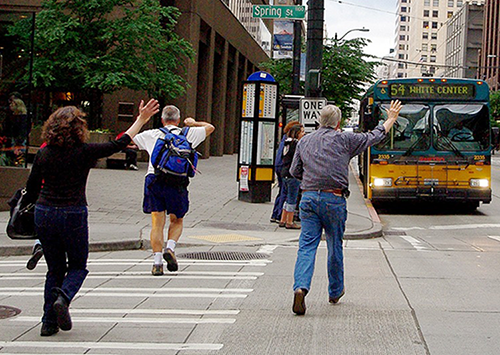If you’re both a reader and regular public transit rider, you’ve had this problem: How do you take your book with you? Reading and library apps are wonderful—I use them all the time—but I always have a print book in my bag. Not every book is suitable for transit, and I’ve tried different formats and narrowed the list of books I’ll pack.
Mass-market Paperbacks
Mass-markets allow publishers to print a large number of books quickly and cheaply. They are a compact 6.75 by 4.25 inches—good for slipping into a bag. Mass-markets have been around since the 1930s, but (for the traveler) there’s a difference between survivors from the late ’60s to the mid ’80s and ones printed today.
Old Mass-markets
No matter how good the story is, picking an older mass-market hinges on quality because they were not made to last. How cracked is the spine? Has the binding disintegrated? Does it have an unforgivable funky odor? To travel, older mass-markets need to be sturdy (so the pages don’t come flying out) but forgiving (enough to allow you to comfortably hold them open). I’ve had luck with surviving Bantam and Penguin Classics. I hold them in one hand, middle finger on the spine, thumb and pinky holding the pages open. But beware: these books are old and could have been anywhere. Make sure your book is clean.
New Mass-markets
For new mass-markets, it comes down to story length and covers. Most will be thin, but if the story is a doorstop (think Stephen King’s It) it could be several inches thick. I cannot overstate how difficult it is to quickly stuff a two-inch-thick mass-market into a small bag. For covers, books bound with glossy paper tend to hold their spines better: they’re flexible and forgiving when you open the book. Matte paper is often stiff—harder to open with easily cracked spines. I’ve seen matte paper spines break because the crack is so severe the book splits apart. There’s not much point in a traveling book you can’t be rough with.
Tor.com Novellas
In 2015, Tor.com (originally a blog under sci-fi/fantasy publisher Tor) began publishing in print, specifically interested in reviving the novella. The novellas are five by eight inches, taller and wider than a mass-market, but much slimmer. These aren’t as easy to hold open with one hand, but the space around the text is a good trade. Though these stories are shorter, they pack a punch because Tor.com views their novellas as “healthy snack-sized chunks” and several of their books appear on the Hugo and Nebula lists each year. That’s a reliably good read taking up less space in your bag. Even with the benefits, I don’t take all my novellas traveling—they’re too pretty to rough up!
Flipbacks or Dwarsliggers
A newcomer to American publishing is the flipback book. These tiny books are 4.7 by 3.2 inches and bound horizontally, intending for you to “swipe up” pages like on a screen. The format was invented by Dutch printer Royal Jongbloed (“dwarsligger” is Dutch) and debuted in 2009. It wasn’t until the president of Dutton Books for Young Readers saw one and collaborated with Royal Jongbloed that the flipback came to the United States. The first wave came in 2018 and were reprintings of John Green’s novels as Penguin Minis. Penguin Random House released more young adult and classic titles as flipbacks the following year. Unfortunately, the last batch was released in October 2019 and there’s currently no more set for publication. Like many traveling readers, I wanted to love them, but I also had trouble with the thin paper sticking together and flipping pages with one hand. I have yet to use a flipback on the go.
Other Tiny Books
There are, fortunately, a few more tiny books circulating the market. The Picador Modern Classics series releases waves of curated titles at a delightful 5.7 by 3.5 inches. Bloomsbury experimented with young adult mini books with reprints of Sarah J. Maas titles in the Miniature Character Collection, 5.5 by 3.7 inches. I haven’t tried either series yet, but the paper quality of both is very promising. The fact that tiny books are still being printed gives me tentative hope for more in the future.
No format has proven to be the perfect pocket book yet, but there are many close matches that will keep me and other traveling readers company as we wait for the next bus.

